|
|
Post by TheWallsScreamedPoetry on Jan 15, 2011 18:03:35 GMT
|
|
|
|
Post by TheWallsScreamedPoetry on Jan 15, 2011 18:14:05 GMT
The Doors 13
The success and continued popularity of 13 over the years was a perfect illustration of the way in which the Doors (and their record label) successfully manipulated the group's image in two distinctly different directions. 13 presented the Doors' most accessible, AM radio-friendly music, even bypassing their rather daring debut single, "Break On Through," in favor of the much more popular "Light My Fire" -- anyone hearing this stuff would perceive the band as an edgy pop/rock outfit with the most intensely brooding vocals this side of Elvis Presley and lots of great tunes and better playing. The reality was a lot more complicated -- the Doors were a challenging, often disturbing, and very serious musical entity, and a big chunk of their work, especially in concert (which was arguably what they were really about), was much more R-rated than the material on 13 would lead you to expect, trading in fierce sexual imagery, sophisticated philosophical ideas, and coarse, even ribald sensibilities worthy of the best bluesmen, all wrapped around a unique blend of poetry and blues, R&B, and jazz-inspired rock. Indeed, one begins to fully appreciate, listening to what almost amounts to the "Doors-lite" sensibilities of this collection, just how much of the group's success, commercial and artistic, was predicated on this split, with a certain percentage of those millions of listeners of the singles making the leap, crossing over to the more serious side of their work and taking in those albums as well as the concerts. Subsequent compilations would mix the two sides more freely, and, ironically enough, later in the same year as the release of 13, Elektra offered the first formal glimpse of that more serious side of the Doors' music with the concert album Absolutely Live; the latter, even with its carefully airbrushed cover shot of lead singer Jim Morrison -- by then very scruffy looking with his beard -- would totally miss the mass appeal enjoyed by 13, with its focus on blues pieces and decidedly adult works such as "Build Me a Woman." The latter quickly started turning up in cutout bins, while 13 remained popular for almost two decades, and became -- along with the group's self-titled debut album -- the most common first Doors album purchased by fans, this despite the fact that it was released too early to contain their last two singles, "Love Her Madly" and "Riders on the Storm" (which made it onto the more FM-oriented Weird Scenes Inside the Gold Mine two years later).
Bruce Eder, All Music Guide
|
|
|
|
Post by TheWallsScreamedPoetry on Aug 19, 2011 11:32:22 GMT
 The Doors: Thirteen The Doors: Thirteen
THE UNFORTUNATE situation epitomized here is that of the record company which has to resort to the "greatest hits" ruse when a band doesn't meet its production quota. Sad but true. And the result of this could truly be damaging to the Doors prestige, if nothing else.
It would seem that the Doors need another smash to make it back to the AM bigtime. 'Roadhouse Blues' didn't exactly do it, at least it didn't make that many waves that I noticed. And the situation would still be in the hands of the AM stations, if not for the blessing, not unmixed of course, of progressive rock FM freeform psychedelic underground pud radio.
The saving grace of this album is that those FM djs are now so bored that they'll play anything new. So the record companies throw their most outrageous brands of garbage at them, and lacking the apparent taste to distinguish (or the time to take notice) the heavy d.j.s put'em on, one after the other. As long as it's a new release. Sound like any other "format" we once knew?
Anyway, there are at least thirteen classic songs, which is much, much more than can be said of the Airplane's recent schlocker. Even if the mere existence of this album is a tad like the male nipple (totally unfunctional, except in terms of arousal and desire for more) and even totally consumeristic, you might want to pick it up. Supposing you missed the Soft Parade album. (Of course 'Five to One' isn't here; funny thing, outside of 'Unknown Soldier' none of the Doors' more controversial subject matter is included.)
There are no magnum opuses mind. No 'The End', no 'When the Music's Over', no 'Soft Parade' – but that doesn't have anything to do with the Doors' success. I guess. Otherwise it would have been here.
It also would have been decidedly uncommercial to have them included here. All of these can be squeezed in between Rubber Ducky and Elton John on the Golden Oldies Weekend. And of course it cannot be ignored that the Doors are by now the most successful of "our" bands (Creedence Clearwater having no implications that extend beyond 3:05 on anyone's turntable). So it's all o.k., probably. Never mind excitement.
It is probably more interesting to note that the credits are now Morrison-Krieger or even solely Krieger (e.g. 'Light My Fire') rather than the former conglomerate. Which is excellent for Robbie, if he gets more bread. Give 'em their due, I always say. It's probably like Apple anyhow and all goes to some corporate window.
Still, in the end you know all about these tunes and either think that the Doors are one of the best, most effective bands in the land or you hate them. Whatever, nobody at all except those mentioned above and the lunatic teenybopper autograph fringe is gonna buy this one. And if it goes solid gold tomorrow we'll know who (or at least how many) to watch out for.
Raise the conciousness.
Dave Marsh, Creem, March 1971
|
|
|
|
Post by TheWallsScreamedPoetry on Jul 20, 2023 16:24:31 GMT
An interesting article on the cover of The Doors 13 compilation. link belowThe Doors 13 Cover 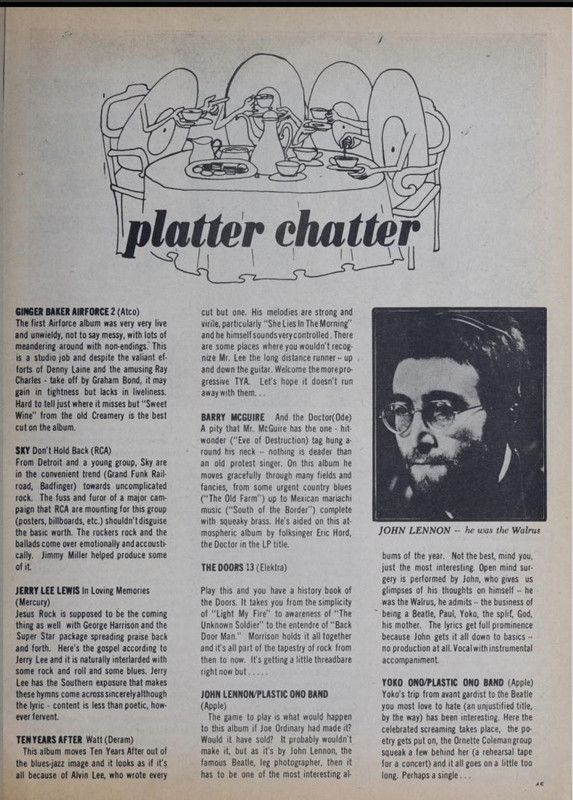 Hit Parader June 1970   Uncut July 2021
|
|
|
|
Post by TheWallsScreamedPoetry on Dec 13, 2023 22:47:16 GMT
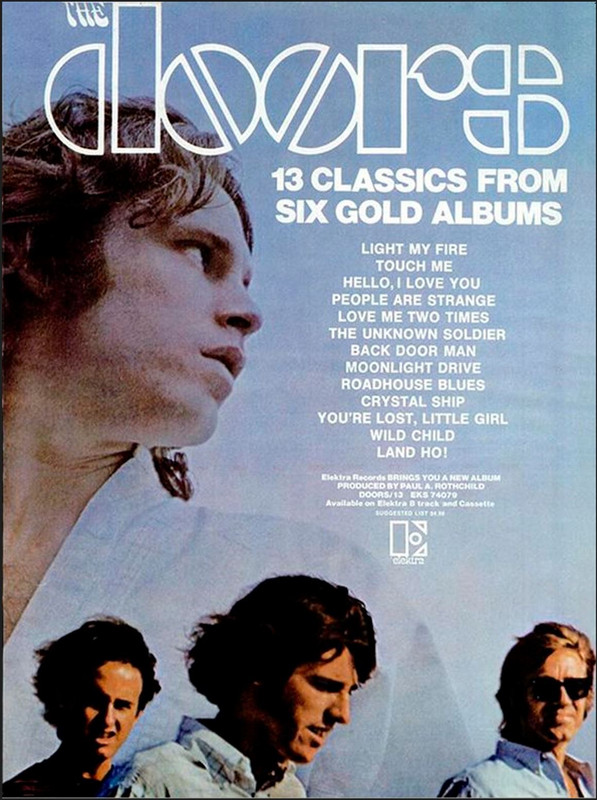  Creem Magazine 1970 |
|
|
|
Post by TheWallsScreamedPoetry on Jan 24, 2024 21:15:31 GMT
The Doors 13 Photoshoot Jim Morrison was not pleased with Elektra's idea for the cover of the bands first compilation LP due to a photo of Jim Jim Morrison was not pleased with Elektra's idea for the cover of the bands first compilation LP due to a photo of Jim
when he was young and pretty.
So a photo shoot was arranged to capture the band in the 'now'.
In April or May 1970, The Doors were photographed by Edmund Teske outside his studio in Hollywood.
One of this set was touted by the band to be the cover of 13.
Probably another consequence of Miami was the record label wanted to sell records to make up for the losses due to Miami and the bans by radio and TV stations that
came because of that.
So what The Doors wanted was no longer of much interest to Elektra and not only did the pretty boy Jim grace the cover of 13 but it dwarfed the other 3 members
which did not go down well and Morrison would get his own back at the end of the year with the LA Woman cover.
The Teske photo they liked was used for the back cover.
      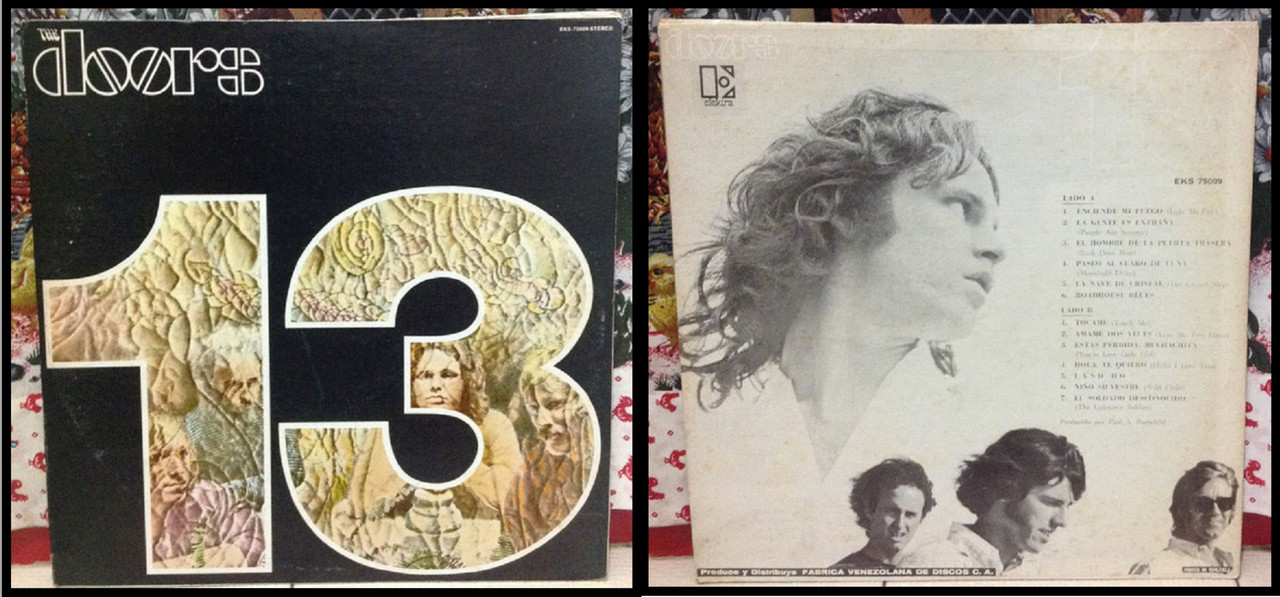 Venezuelan edition cover more in line with the bands vision and pretty Jim relegated to the back. The Doors 13, released in November 1970 on Elektra Records, with designs by Bob Heimall Venezuelan edition cover more in line with the bands vision and pretty Jim relegated to the back. The Doors 13, released in November 1970 on Elektra Records, with designs by Bob Heimall
One of the many unsung heroes of the record marketing business, Art Directors for major labels are principally tasked with having to come up with compelling packaging for the recorded products of a wide variety of musical acts. It takes a unique blend of skills to be able to conceptualize and produce a package that will make a broad range of “clients” – fans, critics, label execs, band management and the musical acts themselves – happy with the final product. Those of us who’ve worked on the creative/development side inside any large media company can strongly sympathize with the challenges faced by Art Directors and their ongoing needs to accept the input and direction of so many hands in the process of most ongoing development efforts (I, for one, don’t miss it one bit!).
Consider, then, what it might have been like to produce an album cover for a band like The Doors – a band that fascinated their legions fans in a variety of thought-provoking (and often outrageous) ways. Incorporating the moods and sensations produced by Jim Morrison’s lyrics and poetry (and sexually-charged on-stage antics) with the band’s superb musicality and then taking into account the expectations of a world-wide fan base, this particular Art Director’s output would ultimately be measured on many levels.
The more pop-oriented performances featured on their fourth album, The Soft Parade (released in the summer of 1969), had confounded both their fans and the critics upon its release (with Morrison's bad habits playing havoc with the recording process). While the record sold well, fans and critics were demanding more, and the band answered with two more albums in early-mid 1970 - the hard-rocking Morrison Hotel and the group's first live album titled Absolutely Live. However, in spite of the critical acclaim and ecstatic support from their fan base during the tour to support these records (which included an appearance at the Isle of Wight Festival), the band's attentions were badly upset by the late-Summer court trial in Miami (and ultimate conviction for indecent exposure and profanity) following Morrison's mid-concert arrest there previous year.
Imagine the degrees of difficulty that were added to the task when, as a freshman Art Director for one of the most-influential records labels of the era, you’re asked to produce this cover artwork for one of the label’s top acts - the band’s first “Best Of” release - during a period of time in the band’s history when egos, drugs, court cases and other internal and external distractions had begun to tear at the fabric of this group's day-to-day efforts. We interviewed the cool-headed AD in question - Bob Heimall - to tap his memory to get the details of this monumental task for this special edition of UnCovered, so sit back, put your eyes on the screen and hands upon your mouse, and read on...
In the words of the artist, Bob Heimall (interviewed in July, 2009) -
I had worked at Elektra (Records) for 3 years as a designer and had previously worked on the in-house production team for the Waiting For The Sun album and then on the inside gate-fold for their The Soft Parade album - I actually chose the illustrator Peter Schaumann for that effort - so I had some contact with The Doors previously. Even though I had worked with them indirectly before, this was going to be the first time I would be working with the band directly with their packaging as Art Director.
I was the promoted to the position of Art Director at Elektra Records in 1970 by Bill Harvey, the General Manager, after the release of the fourth Doors album, The Soft Parade. After four successful studio albums, it was then decided to release a "Best Of" set that would be titled "13". The Doors then came to visit me at my Elektra Records office to discuss the details of the 13 album cover. The band members were familiar with my work for them over the previous 3 years, including all of the advertising, single sleeves, posters, promotions, etc. that I'd done and I had access to all their Elektra photo files, which I thought would be useful in a "Best Of" package.
They, on the other hand, actually came in with a photograph by Edmund Teske, wanting to use it for the front cover. Personally, I was not "blown away by it for use on the cover, but since it was an exceptional photo of the band, we eventually used it for the back cover. You need to understand that, by this time, The Doors had in effect become "the Jim Morrison Band", with Jim getting all the publicity and notoriety - he was truly one of the new "Rock Idols". However, the rest of the band members wanted as much credit as Jim - and they really should have, because of their respective and combined talents - but the Doors' fans, the press and paparazzi remained focused in on Jim.
If you'll take a look at the covers on Waiting for the Sun and The Soft Parade, you'll see that both images treated the band members as equals. Their debut album cover had the photo of Jim superimposed larger with Ray, John and Robbie. Their second album Strange Days was a concept cover - one of the best ever, in my opinion - done my Bill Harvey, who was then Elektra's AD, using a photograph by Joel Brodsky. At this point, though, I could feel the tension in my office as the band said that they wanted an album cover with all of them equal, even though we all knew inside Jim was the "main attraction", so to speak. I cordially said that I would look through all of The Doors photos I had and try and would put together a back cover image from them.
Typically, when artists would give me a rough studio version of their album, I would first play it in my office immediately after they left to get a very rough take on the music and the feelings they were trying to convey. Then, on the way during my commute home to Pound Ridge in Westchester County, NY – which was about an hour and a half each way, I would light up a joint and turn up the volume to get completely absorbed. The car always seemed to know the way home. After getting home and having dinner with my wife and daughter, I would then have a few drinks, smoke another joint, put on the record or tape, then turn it up and get into the music. On the morning commute back into the city, I would listen to it "straight" to get a fresh different perspective.
I would immerse myself in the music for a full week at least - sometimes longer and over the weekends - to make sure I really had a feel for the songs and the artist. This way, I was always certain that when I came up with the visual idea and presented it to the artist- it fit perfectly to the music, the message, and the artist.
As I said before, I personally did not think that the photo they brought in was right for a cover shot - it lacked "punch" - and what both I and the record company wanted for this cover was Jim Morrison out front. Remembering that the album cover budget was set by Elektra - although, based on The Doors' record sales, they could have had almost anything they wanted - I set about working on this new cover project.
It took about a week to come up with my cover idea, going through hundreds of photos looking for a "better" front cover or, if not, at least some other good shots for the back. I had found two separate photos taken by Bill Harvey of the band in California a few years prior. One was of Jim looking rather "ethereal" and the other one was of Robbie, John and Ray together. Both photos were a little over exposed, and when I sandwiched them together inside a square matte, I knew I had a winner! Once that work was done, I then experimented with different color techniques and schemes for the Edmund Teske B&W photo for the back so that it would compliment the front. I ultimately decided to use the sky blue ethereal theme from the front and sent the sandwiched slides of the front out for a 12 3/8 x 12 3/8 color print and made a photo stat of the B&W back cover and hand tinted it in blue to match the front. At last, I was ready to show the band what I'd done. After all the work I had done, I was very confident that my idea was perfect for this project and was able to "sell it to them" with confidence.
When The Doors first came to me to put this cover together, they'd hoped that I would use the Edmund Teske black & white photo for the cover, and other photos of the band for the back cover. When they saw what I created for the cover, though, they were all blown away! Right then, all were in agreement that it should be used as their first "Best Of" album cover. The Doors absolutely loved the cover, and I was told later by Jac Holtzman - the owner of Elektra Records - that Jim later came into his office and told Jac to "take care of me" as I was very talented!
One interesting Doors-related side note – a few months before working on the 13 cover project, when the band came to NYC to play some concerts at Bill Graham’s Fillmore East, I had a backstage photographer’s press pass and photographed all their concerts in NYC . I was in the front of the crowd below the stage taking photos of the Doors with my fellow photographer buddy, Linda Eastman (of the Eastman Kodak family). She chided me that she was going to marry one of these stars one day! I was like “Yeah, sure you will, Linda!” Of course, it turned out that she married Paul McCartney a few years later, and the joke was on me! I did get something more from that experience, though – I used two of my photos of Jim Morrison from this concert on the inside gatefold of The Doors Absolutely Live cover.###I can't believe in any way Morrison was OK with the cover nor the band now reduced to a tiny back up role.
Morrison figured that one out from 1965 when he suggested each member got 25% of everything thus handing tens of millions to the rest of the band.
But as I said Elektra needed some album sales so The Doors view was inconsequential and the first compilation had a Morrisoncentric cover which I myself thought was excellent when I bought it in 1972
unaware of any of the drama of the debut cover up to this one.
|
|
|
|
Post by TheWallsScreamedPoetry on Jan 25, 2024 11:40:45 GMT
 13 Reel to ReelCassette 13 Reel to ReelCassette

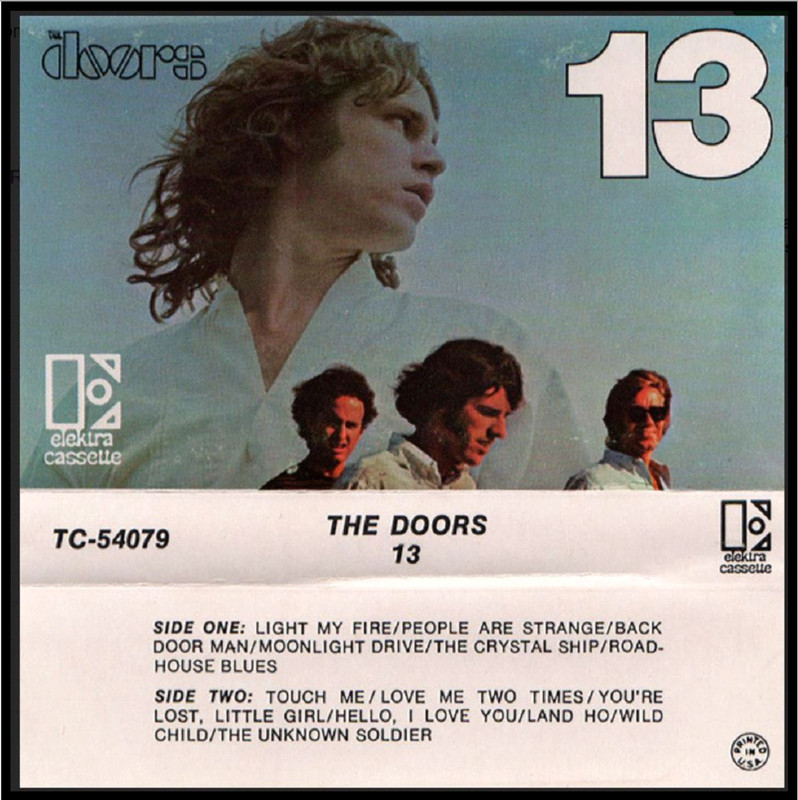
8 Track


4 track

Radio Station Promo |
|
|
|
Post by TheWallsScreamedPoetry on Jan 25, 2024 11:57:48 GMT
The Doors '13' 50th anniversary LPsFor the albums 50th anniversary Elektra put out a 180g vinyl LP remastered by Bruce Botnick in 2020.
Also as a tie in with Barnes & Noble they released a blue/white swirl vinyl LP collectors copy.
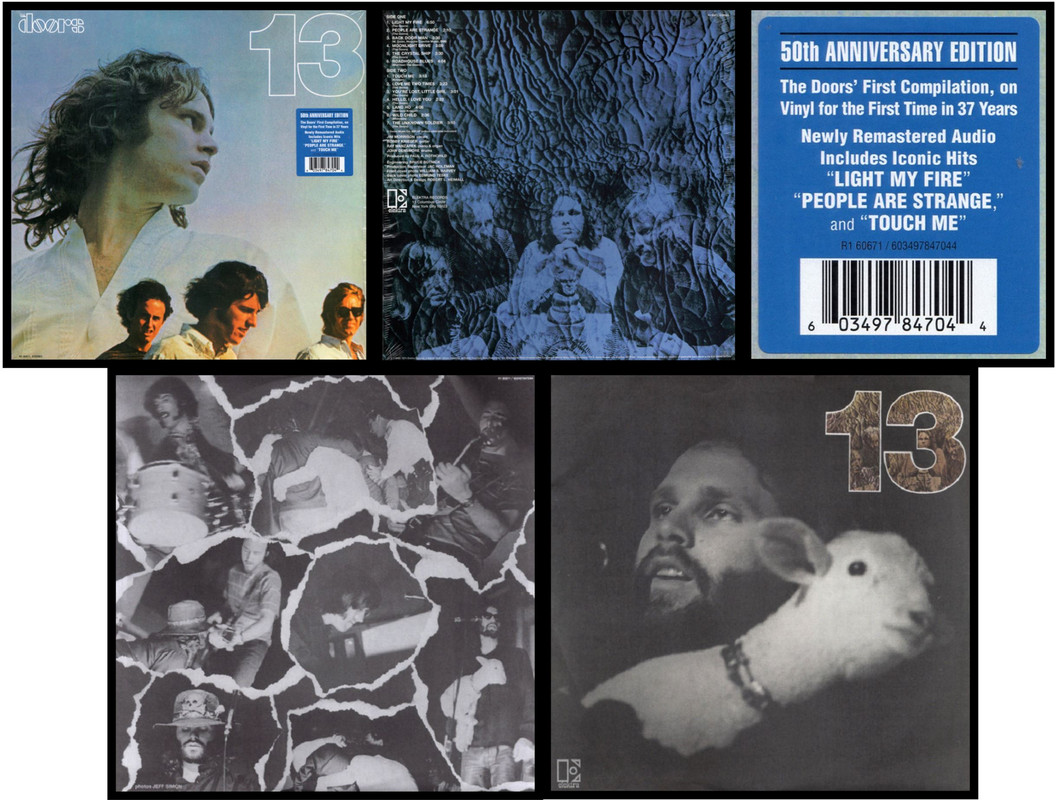
Doors' First Ever Compilation Album Celebrates 50th Anniversary with New Remastering by Longtime Engineer/Mixer Bruce Botnick!
The Doors' very first compilation 13, originally released in 1970, turns 50 in 2020 and to celebrate this milestone it will be available for the first time in 37 years!
This 50th Anniversary vinyl LP edition features remastered audio by The Doors' longtime engineer/mixer Bruce Botnick and comes housed in a meticulously reproduced version of the original artwork including record labels and the printed inner sleeve.
Subtitled A Collection of Thirteen Classic Doors Songs, it was the only Doors compilation issued during Jim Morrison's lifetime and includes "Light My Fire," "Roadhouse Blues," "People Are Strange," "Love Me Two Times," and "Hello, I Love You."    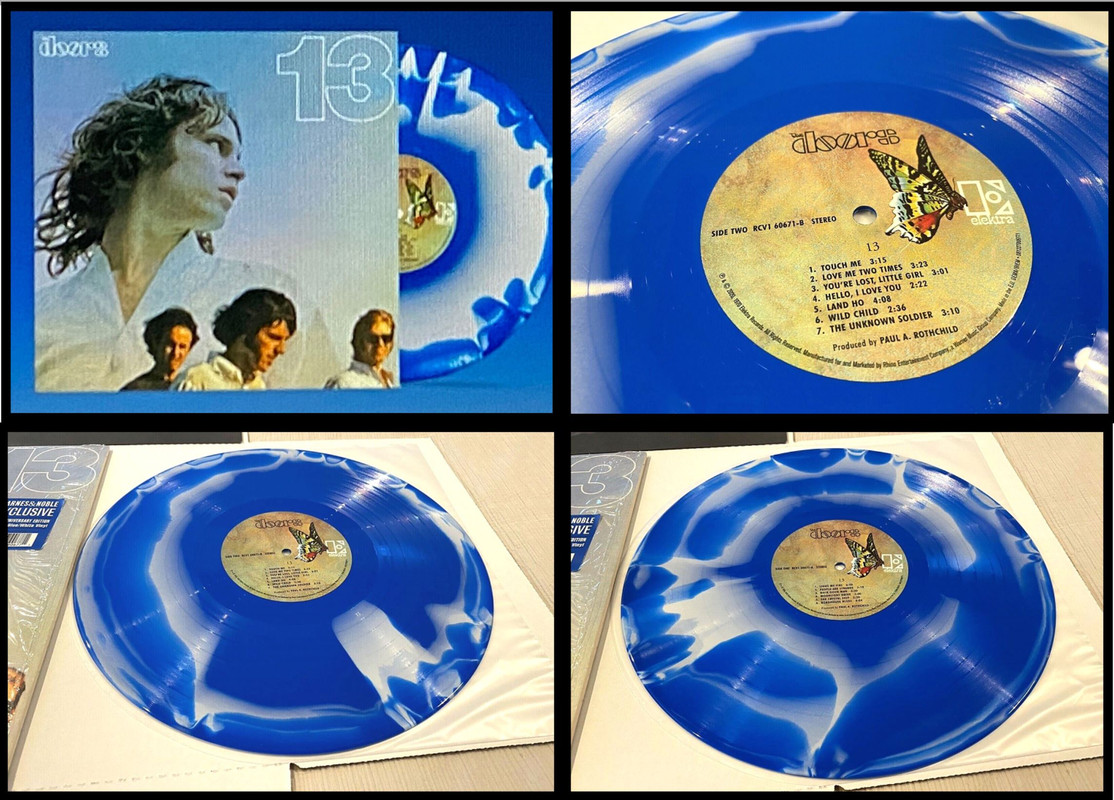 
|
|